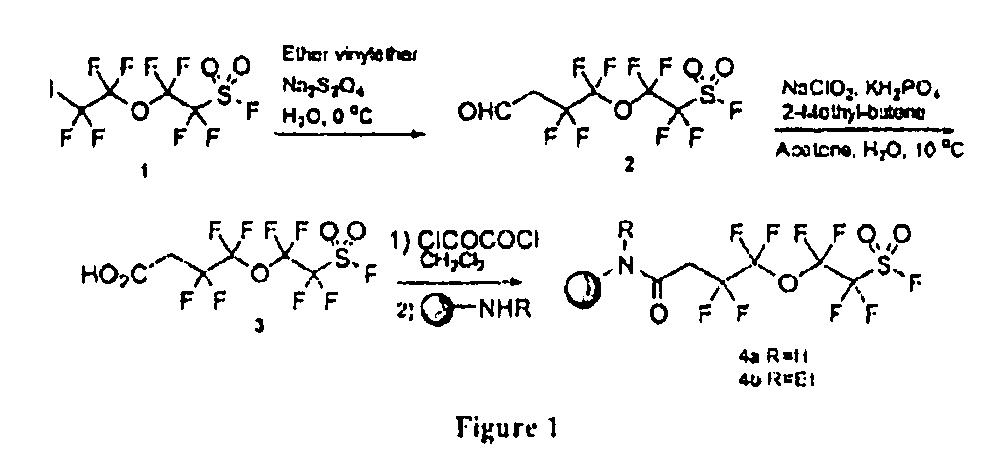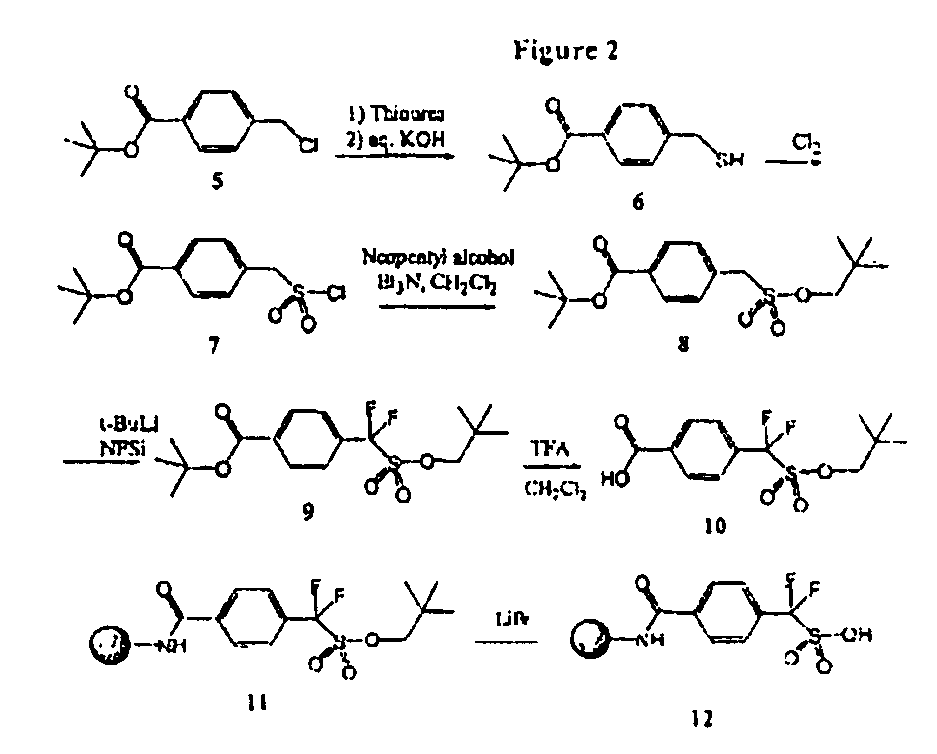Perfluoro sulfonyl halides and related species as polymer support modifiers
a technology of perfluoro sulfonyl halide and polymer support modifier, which is applied in the direction of library linkers, chemical library materials, catalytic reactions, etc., can solve the problems of inability to utilize nafionTM resin in high yield and conversion in solid-phase organic synthesis applications, and inability to be wet or swollen by most aprotic organic solvents, etc., to achieve the effect of increasing the reactivity of the activator portion
- Summary
- Abstract
- Description
- Claims
- Application Information
AI Technical Summary
Benefits of technology
Problems solved by technology
Method used
Image
Examples
example 1
[0316]This example illustrates the preparation of a polymer-supported perfluorosulfonyl fluoride linker (FIG. 1).
[0317]At 0° C., to a stirring solution containing ethyl vinyl ether (600 mg, 8.3 mmol), NaHCO3 (680 mg, 8.0 mmol), and commercial tetrafluoro-2-(tetrafluoro-2-iodoethoxy)ethanesulfonyl fluoride FIG. 1, Structure 1 (3.5 g, 8.0 mmol) in CH3CN (8 mL) and H2O (7 mL) was slowly added Na2S2O4 (1.4 g, 8.0 mmol). The reaction mixture was stirred at 5° C. for 50 min. The pH of the reaction mixture was adjusted to 6.2˜7.0 by adding 3.0 N aqueous HCl and the mixture was stirred at 25° C. for another 20 min. The reaction mixture was extracted with CH2Cl2, washed with water and concentrated under reduced pressure. The oily residue was dissolved in acetone (38 mL) and the solution was added to a stirring mixture of 2-methyl-butene-2 (36 mL), NaH2PO4 (4.0 g, mmol), NaClO2 (5.0 g, mmol) and water (40 mL) at 0-5° C. The reaction mixture was stirred at 5-15° C. for 2 h. The reaction mixtur...
example 2
[0319]This example illustrates the preparation of difluorosulfonic acid linker and the resin-bound difluorosulfonic acid (FIG. 2).
[0320]A solution of chloride FIG. 2, Structure 5 (3.8 g, 16.8 mmol) and thiourea (1.3 g, 17 mmol) in EtOH (10 mL) was stirred at 70° C. for 4 h and then cooled to room temperature. A solution of NaOH (1.2 g, 30 mmol) in water (10 mL) was added, and the reaction mixture was stirred at room temperature overnight, concentrated under reduced pressure, acidified to pH 6, extracted with CH2Cl2, washed with water. The crude thiol FIG. 2, Structure 6 was dissolved in CH2Cl2 (30 mL), water (30 mL) and acetic acid (2 mL). The solution was cooled to 0-5° C. and Cl2 gas was bubbled onto the solution for 1 h. The reaction mixture was concentrated, extracted with CH2Cl2, washed with cold water, dried (MgSO4) and concentrated to give sulfonyl chloride FIG. 2, 7 (4.8 g, 97% / o). 1H NMR (CDCl3, δ): 1.60 (s, 9H), 4.92 (s, 2H), 7.68 (d, 2H), 8.38 (d, 2H); 13C NMR (CDCl3, δ):...
example 3
[0324]This example illustrates the use of perfluorosulfonyl fluoride linker in deoxygenation of various phenols (FIG. 3).
[0325]A mixture of phenol (0.68 mmol), K2CO3 (100 mg, 0.72 mmol), resin-bound linker FIG. 3, Structure 4 (80 mg, 0.034 mmol) and DMF (1.0 mL) was shaken at room temperature overnight. The resin was washed with water, DMF and CH2Cl2, and was dried under vacuum overnight to give resin-bound phenol FIG. 3, Structure 13. To the dry resin FIG. 3, Structure 13 were added Pd(OAc)2 (6.0 mg, mmol), 1,3-bis(diphenylphosphino)propane (dppp, 16.0 mg, mmol), DMF (1.2-1.4 mL) and a mixture of HCO2H (180 μL) and Et3N (460 μL). The mixture was shaken at 85° C. for 120 min. The polymer beads were filtered and washed with Et2O. The combined organic phase was washed with aqueous Na2CO3 and water, and evaporated to dryness. The residue was dissolved in Et2O and eluted through a short column of SiO2 to remove inorganic residues. The crude products were purified by preparative TLC to g...
PUM
 Login to View More
Login to View More Abstract
Description
Claims
Application Information
 Login to View More
Login to View More - R&D
- Intellectual Property
- Life Sciences
- Materials
- Tech Scout
- Unparalleled Data Quality
- Higher Quality Content
- 60% Fewer Hallucinations
Browse by: Latest US Patents, China's latest patents, Technical Efficacy Thesaurus, Application Domain, Technology Topic, Popular Technical Reports.
© 2025 PatSnap. All rights reserved.Legal|Privacy policy|Modern Slavery Act Transparency Statement|Sitemap|About US| Contact US: help@patsnap.com



